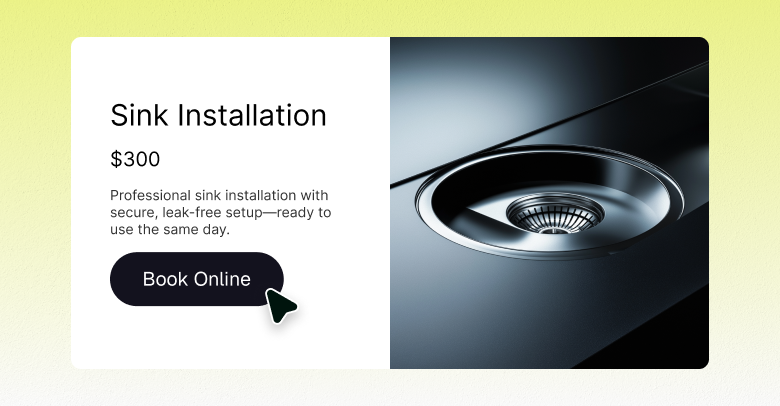Not that long ago, eCommerce was considered a “nice-to-have” for many SMBs. Today, it’s becoming a must. Just look at the numbers: Global eCommerce revenue is projected to grow at
9.49% annually through 2029. Customers expect to book, browse, and buy online, whether they’re shopping for products or scheduling a plumbing service. SMBs that don’t adapt will be left behind.
But here’s the catch: Many SMBs still hesitate to embrace eCommerce. They see it as expensive, complex, and hard to maintain, especially service-based businesses where “selling online” doesn’t feel like a natural fit.
Take a classic example: a local plumber. Their website probably acts more like a business card than a sales tool - a basic list of services, a phone number, and maybe a contact form. The idea of turning that into an “online storefront” can feel like a big leap. After all, they’re not selling products. But eCommerce for a plumber actually means offering service-based “products” and accepting payments in advance (or after the job is done). Many SMB owners don’t realize that these features still count as eCommerce, and that they can make a real difference in how smoothly and profitably their businesses run.
That’s where you come in. As the agency partner, you have the opportunity to tear down the perceived walls of eCommerce and show clients, plumbers, or else, how eCommerce can make their business more efficient, accessible, and profitable.
The agency angle
For digital agencies, this evolution isn’t just a shift; it’s a major opportunity. By helping SMBs adopt eCommerce, agencies can:
- Enhance client value:
eCommerce capabilities immediately level up your services. Helping a local plumber go from “call us” to “book online” creates real, measurable impact, not just for their operations, but for customer experience, too.
- Increase client retention: Agencies that offer multiple services, including eCommerce, see higher client retention rates (Vendasta's research). Why? Because clients who rely on you for more than just design or SEO are more likely to stick around. A plumber who sees more consistent jobs thanks to online booking isn’t going to jump ship anytime soon.
- Drive revenue growth: Expanding your service portfolio can lead to increased revenue streams.
Agencies are uniquely positioned to guide SMBs into their next phase of growth, but that means making a compelling case for eCommerce. Before tackling the barriers, it’s important to focus on the value. When clients understand what’s really at stake, the reach, the revenue potential, the competitive edge, eCommerce shifts from a scary upgrade to a necessary and strategic one.
Why eCommerce is a no-brainer for SMBs
The appeal of eCommerce goes far beyond just selling products online. It gives SMBs a way to reach more customers, operate beyond business hours, and respond to growing consumer expectations for convenience and speed. Whether it’s booking services, selling gift cards, or accepting online payments, eCommerce brings a new level of flexibility to how SMBs operate.
Take the local plumber example. They’re not shipping out products or managing inventory, but they are managing appointments, taking calls, and chasing down payments. With eCommerce, they can let customers book appointments online and pay upfront or after the service is provided. That’s not just more convenient for the customer, it also simplifies the plumber’s day and helps reduce no-shows. That’s eCommerce for you.
Yet despite the upside, many SMBs remain hesitant. The opportunity is there, but it’s not always an easy sell. For agencies, the next challenge is understanding what’s holding clients back and how to meet them where they are. That starts with identifying the real-world concerns that make eCommerce adoption feel out of reach.
Understanding SMBs’ hesitation
The hesitation often comes down to perception: that it’s too complicated, too expensive, or simply not a fit for how the business works.
Getting back to our plumber. They might assume that “going eCommerce” means turning their site into a full-blown online store with inventory, product listings, and a shopping cart, none of which feels relevant to their day-to-day. What they don’t see is how eCommerce can be adapted to support a service-based model. Things like online booking can make their operations smoother without adding complexity.
Here’s a breakdown of the most common concerns agencies will need to address:
- Perceived complexity: Worries about the technical aspects of managing an online store, especially for non-tech-savvy business owners like plumbers.
- Cost implications:
Concern that implementing eCommerce features will require a significant financial investment and additional fees.
- Relevance to the business model: Uncertainty about how eCommerce translates to services rather than products, particularly in industries like home repair, personal care, or consulting.
A lot to worry about, and it’s your job, as an agency, to address these concerns and present eCommerce as a flexible solution tailored to SMBs' workflows that aligns with their specific needs.
Addressing concerns with the right solution - Enter Duda eCommerce
Helping SMBs overcome their hesitation around eCommerce starts with reframing what eCommerce actually means for them. Most aren't looking to build an Amazon-style operation; they simply want to make it easier for customers to interact with their business. That’s where agencies come in: demystifying the process and delivering tailored solutions that are simple, scalable, and specific to each client.
Duda’s eCommerce solution for service-based businesses is designed to remove the friction points that often scare SMBs away from adopting eCommerce. Here are a few examples of features and benefits:
- Offline Payments
Many service-based businesses, like our plumber, still operate on a cash-only basis or accept payments in person. With Duda’s Offline Payments option (also called
Manual Payment), businesses can accept payments through bank transfers, checks, cash on delivery, and even phone payments, offering clients flexibility while supporting a digital workflow.
- In-Store Pickup
Not every SMB is ready to handle shipping logistics. With Duda’s In-Store Pickup, businesses can let customers browse and pay online, then collect their purchases in person, blending traditional operations with modern eCommerce expectations.
- Multiple Product Types
From service appointments and event tickets to digital downloads and donations (‘digital products’), Duda supports a wide variety of product types. This makes it perfect for service providers and niche businesses that want to offer more than just physical products.
- Built-in AI Assistant
Enables SMBs to go live faster by utilizing
Duda’s AI Assistant to generate engaging product descriptions, images, suggested prices, SEO meta titles, and descriptions, as well as alt text tags for every image.
- No transaction fees
As eCommerce is perceived as expensive and involving additional fees, which could be quite a burden on the cash flow of your classic SMB, no transaction fees are a great selling point.
- Intuitive and easy to maintain
An intuitive store-building experience that allows agencies to transform existing brochure-style sites into 24/7 storefronts, all within a user-friendly interface that is a natural extension of the Duda platform. Also, Duda eCommerce empowers SMBs to operate these online stores in the same easy way they are used to operate their physical business or store.
For the plumber, it doesn’t make much sense to start with a full-blown online store (to be honest, I’m not sure if there’s a case for that at all). You can start by offering service appointments, seasonal plumbing checks, and annual maintenance plans, and implementing Duda’s
Multiple Product Types feature.
Additionally, you can offer offline payment options, allowing customers to pay after the job is completed.
These aren't radical changes, they’re smart tweaks that align with how today’s consumers already expect to interact with businesses.
eCommerce? Yes, please!
Once clients understand that “eCommerce” can be as simple as turning their contact form into a booking system, they stop seeing it as a scary upgrade and start seeing it as a smart move. It’s all about meeting their customers where they are: on their smartphones, at their convenience, 24/7. And by doing so, you’re helping SMBs increase customer satisfaction, operational efficiency, and revenue, all without the complexity they fear.
The bottom line is that eCommerce isn't reserved for giant retailers or businesses with huge inventories. SMBs, from plumbers to yoga studios to local coffee shops, can harness the power of eCommerce to build stronger customer relationships and streamline their operations. The question isn’t whether or not eCommerce is right for your clients; it’s how you can help them get started in a way that feels natural, manageable, and profitable.
So, when the next client hesitates at the thought of eCommerce, remember: it’s not a huge leap. It’s a series of small, manageable steps that can completely transform the way they do business. And with your expertise, they’ll be ready to say, “eCommerce? Yes, please!”
Ready to bring eCommerce to your SMB clients?
Duda’s eCommerce solution is perfect for SMBs looking to grow their digital presence without the headache. Start transforming your client websites today with easy-to-use tools that empower them to accept online bookings, payments, and more.
Want to see Duda’s eCommerce in action?
Start a free trial
and choose the “Sell Online” option on the left panel.







